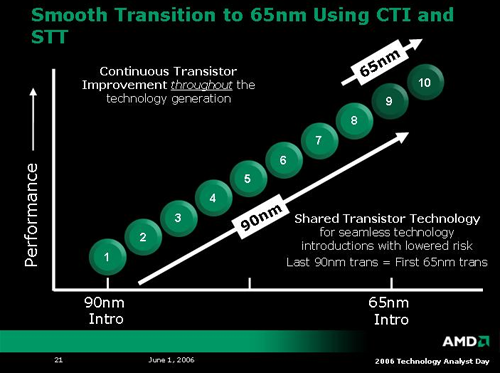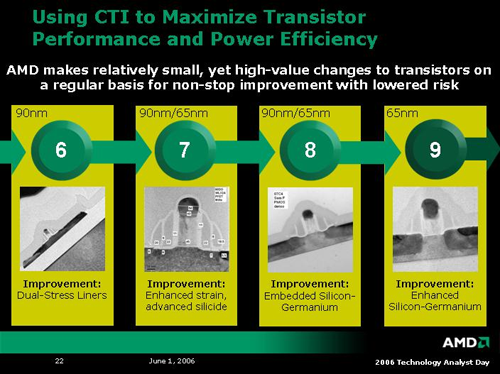Introduction & Manufacturing
AMD held its spring Analyst Day on Thursday, and we were able to sit down and enjoy the webcast. While we fully expected to learn about AMD's next CPU architecture, K8L, we were pleasantly surprised to find a few unexpected extras. The event covered a huge swath of the computing industry in a manner that went just deep enough to leave us screaming for more. Unfortunately, we don't have all the answers we wanted today, but we do have some good ideas about what we'll be seeing in the near future about AMD's upcoming technology.
As could be expected, the day started off with an overview of AMD's fabrication strategies. In the near term, AMD is transitioning from 200mm wafers for its 90nm SOI process to 300mm wafers. This will help serve to get AMD up to speed with 300mm wafer before volume production of 65nm devices begins. As 200mm wafer production is phased out, 65nm processes will be ramping into full swing. AMD plans on an aggressive schedule for transitioning to the smaller process technology, and an even more aggressive schedule for pushing out 45nm technology after this product cycle. As of now, AMD plans to introduce production 45nm silicon only 18 months after 65nm hardware hits the market.


In moving to 65nm, AMD has adopted a strategy of constant improvement of its current transistor technology to ensure a smooth transition. The last generation 90nm parts will overlap the first generation 65nm parts, as many of the key features of their structures will be shared. AMD calls this Shared Transistor Technology and Continuous Transistor Improvement. As small improvements are made over the entire life cycle of a process, the final transition from one type of process to another is made much easier.


After AMD showed off a bunch of slides about how their fab is better than your fab, they started to touch on a few topics that really get our groove on: platform architecture. AMD introduced three new platform initiatives, and talked a little bit about their K8L architecture. First we'll talk about the direction AMD is moving with their platform technology.
AMD held its spring Analyst Day on Thursday, and we were able to sit down and enjoy the webcast. While we fully expected to learn about AMD's next CPU architecture, K8L, we were pleasantly surprised to find a few unexpected extras. The event covered a huge swath of the computing industry in a manner that went just deep enough to leave us screaming for more. Unfortunately, we don't have all the answers we wanted today, but we do have some good ideas about what we'll be seeing in the near future about AMD's upcoming technology.
As could be expected, the day started off with an overview of AMD's fabrication strategies. In the near term, AMD is transitioning from 200mm wafers for its 90nm SOI process to 300mm wafers. This will help serve to get AMD up to speed with 300mm wafer before volume production of 65nm devices begins. As 200mm wafer production is phased out, 65nm processes will be ramping into full swing. AMD plans on an aggressive schedule for transitioning to the smaller process technology, and an even more aggressive schedule for pushing out 45nm technology after this product cycle. As of now, AMD plans to introduce production 45nm silicon only 18 months after 65nm hardware hits the market.


In moving to 65nm, AMD has adopted a strategy of constant improvement of its current transistor technology to ensure a smooth transition. The last generation 90nm parts will overlap the first generation 65nm parts, as many of the key features of their structures will be shared. AMD calls this Shared Transistor Technology and Continuous Transistor Improvement. As small improvements are made over the entire life cycle of a process, the final transition from one type of process to another is made much easier.


After AMD showed off a bunch of slides about how their fab is better than your fab, they started to touch on a few topics that really get our groove on: platform architecture. AMD introduced three new platform initiatives, and talked a little bit about their K8L architecture. First we'll talk about the direction AMD is moving with their platform technology.










40 Comments
View All Comments
MrKaz - Monday, June 5, 2006 - link
Did you talk someone at AMD if they have some one interested (or going to do) some SQL accelerator, or CAD calculations accelerator, or even multimedia accelerator accelerator?It would be nice to boost the performance of SQL by 2X, or even media encoding from minutes to seconds...
DerekWilson - Tuesday, June 6, 2006 - link
they are certainly talking heavily about the possibility of hardware like that, but no hardware designers have commited to building anything yet.IntelUser2000 - Sunday, June 4, 2006 - link
No. Because Core Duo(Yonah) with inferior decoder configuration, inferior memory bandwidth(which won't matter a lot but will make slight difference) and platform, still manages to outperform the current K8's. The Pentium M, which is even worse than Core Duo(slightly) still manages to outperform the K8's in integer. Now put Core with integrated memory controller, and comparison will look like Core Duo against Athlon XP.
Core microarchitecture will exceed K8's in general integer architecture, and at least equal in K8L's ability. Integer superiority is still gonna be there, K8L will be faster than Core in FP and SSE performance because of low latency integrated memory controller with lots more real-world bandwidth(well that depends on how AMD implements SSE, Intel may still have an advantage if AMD puts a poor implementation like they did with Athlon XP's SSE, or at least it looked poor).
JarredWalton - Sunday, June 4, 2006 - link
If ~33% of all instructions are Loads, and K8 pretty much totally lacks the ability to reorder Loads, adding that feature could substantially boost performance. It definitely "has a shot" at beating Core, but it may also fall short. Anyone making blanket statements one way or the other - i.e. it *will* beat Core, or it *won't* come close - needs to take a step back and check what they really know and what they are just assuming.At present, AMD is saying K8L is going to have the ability to reorder Loads. They might only do minor reordering, or they might go so far as to have something similar to Conroe's memory disambiguation. Given that AMD hasn't done a major update to K8 in over 3 years (no, DDR2 controller and going dual core don't really count as major updates to the underlying architecture), K8L could be a lot of things. It migth only match Core Duo 2 on a clock-for-clock basis; it might fall short; it might even come out ahead. Also, there has been no indication that Intel is seriously planning on-die memory controller in the near future, probably to continue to protect their chipset market.
Personally, I really hope AMD manages to basically match CD2 performance, because runaway performance leads don't help the consumer. In the end, theoretical integer, PF, SSE, etc. performance isn't as important as real-world application performance. Right now, it's just too soon to declare a victor in the Core Duo 2 vs. K8L match-up. CD2 vs. K8 is already pretty much a done deal, though, and there's no indication that AMD will be able to come out on top in that rivalry. K8L is their "counterattack", and that's the architecture that needs to compete with CD2.
IntelUser2000 - Sunday, June 4, 2006 - link
It's easy to see the performance in integer against Core. Core has ability to reorder loads, but Core Duo is in same situation as K8, it doesn't really have the ability either. Other than that, on the basic block diagram, K8 is superior architecturally to Core Duo, yet Integer performance is somewhat better on Core Duo. The difference probably goes deeper than that. One of the articles mention K7/K8 has similar technique to Intel's micro op fusion. It could be Intel's is much better, etc. If a K8 with substantially better microarchitecture(+ODMC) can't beat integer performance of Core Duo, will K8L with basically same microarchitecture(or may be worse) beat Core?? It's simple to see it probably won't.
DerekWilson - Tuesday, June 6, 2006 - link
core duo can reorder loads as the Pentium M could reorder loads --http://anandtech.com/cpuchipsets/showdoc.aspx?i=27...">http://anandtech.com/cpuchipsets/showdoc.aspx?i=27...
MrKaz - Monday, June 5, 2006 - link
P3 on steroids may beat the K7 on steroids in performance.But performance isn’t everything or Intel employees where out of job since K7 came out and beat P3 and P4. And Intel didnt recover yet!
I didn’t see any presentation of Intel new architecture, but I bet even the Hammer look better than any thing Intel will release.
http://www.amd.com/us-en/assets/content_type/Downl...">http://www.amd.com/us-en/assets/content...ableAsse...
4MB cache, 128bit SSE that tells me nothing. Other than the P3 started with PC100 SDRAM, 256Kb cache and SSE and it's now at DDR2 667, 4MB cache and SSE4.
Sceptor - Saturday, June 3, 2006 - link
Finally a real interconnect that can be used for a serious co-processor...perhaps a physics co-pro not limited by the PCI bus would help smooth transition to more realistic games.Or a dedicated video co-pro to use with Cad or 3D Modeling programs...
od4hs - Friday, June 2, 2006 - link
http://images.anandtech.com/reviews/cpu/amd/analys...">http://images.anandtech.com/reviews/cpu/amd/analys...
-> UK firm to unveil wall-socket PC
The Jack PC thin client fits into a wall socket and is so energy-efficient it can get its power over Ethernet
http://news.zdnet.co.uk/0,39020330,39272166,00.htm">http://news.zdnet.co.uk/0,39020330,39272166,00.htm
lopri - Friday, June 2, 2006 - link
I totally agree that the "direct connect" is the most desirable way but I cannot help but think AMD is somewhat daydreaming. That is, what's showing in the slides seems way ahead of today's "practicality".I mean, we've had this PCI Express which has been strongly pushed by core logic vendors, but so far all we practically have are video cards. I sometimes think all these mobo makers pay more attention to "asthetic" point when they design PCI-E slots so the boards look prettier. (lol)
If my understanding is correct, AMD will introduce a new type of slot, HTX, on motherboards. Will other technology/market follow? Or will it just give another chance to graphics card manufacturers to push us to buy new cards? On today's desktop boards, basically everything is "integrated", sans video. I know that a video card has its own core and frame buffer, and transfers data via Hyper Transport, but if a physics card can utilize the HTX, what stops a video card from connecting directly to CPU, without passing the core logic or system memory?
I think this will also be closely related to the available bandwidth of HTX per CPU core (or cores), and I can't really think of any add-in board that'll prioritize the bandwidth other than video cards, (OK and the physics cards) even though the HTX will be an open standard. (look at the lazy/lame Creative)
A very desirable case would be where storage (hard disks) can take advantage of this "direct" connection but then again there is a such thing called "memory", so my imagination stops there. (maybe solid-state/I-Ram type of storage can make use of the HTX? Then what's the use of memory? Taking care of I/O?) Talking about I/O, I just thought it'd be interesting to see keyboards/mice connect to CPU via HTX. (Sorry I couldn't resist)
All in all, like the article says, this roadmap seems just too broad/ambiguous/futuristic. I'm not a CPU engineer so my thinking could be totaly off, though. If so, please enlighten.
lop